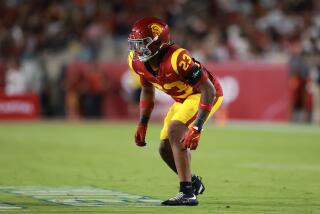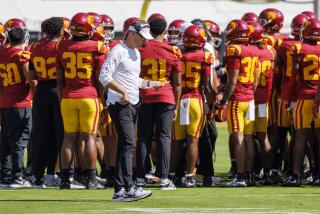MEN OF STEAL
No one yelled “Oskie.”
That is a code word USC defensive players sometimes yell when one of them intercepts a pass or scoops up a fumble. That means everyone else turns around and looks for someone to block.
No one yelled anything when Troy Polamalu intercepted a pass against Penn State in the season opener but, as he looked upfield, Polamalu saw teammates hustling to set up his 43-yard touchdown return.
“Some awesome blocks,” the strong safety said. “Even if I was in a wheelchair, I could have scored.”
Defensive touchdowns and turnovers have become almost second nature at USC. The defense scored eight times last season and led the nation in takeaways--averaging more than three a game--after ranking second in that category in 1998.
The defense was designed that way. Polamalu and his teammates are coached to attack opposing offenses, swarming to the ball, scrambling for fumbles and interceptions.
That can leave USC vulnerable to occasional big plays and penalties, miscues that can translate into losses. It is a risk the team has chosen to take since Bill Young became defensive coordinator two years ago.
“This is what we want to be,” Young said. “There’s always going to be a strength to one thing and a weakness to another. We think this is a sound philosophy.”
Young instituted similar schemes as an assistant coach at Oklahoma and Ohio State before coming to USC when Coach Paul Hackett was hired in 1998. The Trojan squad he inherited was accustomed to a different style.
“They were more of a flat-footed, read-and-react type of player,” he said. “The footwork wasn’t what we wanted.”
Under the new system, Young told his defensive linemen to pin their ears back and penetrate. He asked safeties to gang-tackle at the line of scrimmage and cornerbacks to play more bump-and-run.
And he wanted them all to go after the ball.
“You don’t have to be a great athlete to reach in there and knock it out,” Young said. “You don’t have to be a great athlete to fall on it.”
The change took effect quickly that first season, turnovers coming in bunches. But 1999 was rougher in that USC was more prone to giving up big plays. Now, with nine returning starters who are familiar with his system, Young has challenged the squad to minimize breakdowns while maintaining the pressure.
So, along with its other drills, the defense devotes practice time to creating turnovers.
There is a technique, for instance, to forcing fumbles. The first man wraps up the runner while the second and third men try to strip the ball.
There is also an element of hustle, with everyone else converging on the play. As linebacker Markus Steele said, even the farthest defender must run to the action “because you never know when the ball is going to pop out.”
Finally, there is a mental component. Though players say they love flying to the point of attack--”taking the fight to the opponent,” as Young says--they must choose when to gamble.
“You’ve got to read your keys,” Polamalu said. “You’ve got to do your job first, then go for the ball.”
The exciting part begins on those occasions when the defense gets hold of the football. Players such as Polamalu, a running back in high school, get to show their open-field moves.
That is part of the practice routine too, defenders working on their blocking and returns.
“Oskie . . . everyone hears that and just runs,” linebacker Zeke Moreno said. “When we score, that’s the best feeling. We know we did our job, and extra.”
Saturday, the job will be to contain a Colorado offense that showed a balanced attack in its opener, rushing for 223 yards and passing for 309 against Colorado State.
The Buffaloes had no turnovers in that game but will start an inexperienced quarterback and, perhaps, a freshman at tailback. They will face a USC defense that reminds Colorado Coach Gary Barnett of the squad he saw in the 1996 Rose Bowl, when he coached at Northwestern.
“They had a great defense when we played them,” he said. “Darrell Russell and a lot of guys who are in the NFL. There’s a comparison here. The same kind of athletes.”
Athletes who are hungry to get their hands on the ball. Even with a touchdown against Penn State, the defense fell short of its weekly goal of three turnovers.
The players have been reminded of this by their coaches. They have been informed that Washington, a Pacific 10 Conference foe, came up with five turnovers in its opener against Idaho.
They will be told, again and again, before the game at the Coliseum on Saturday.
“We’re very demanding about turnovers,” Young said. “We’ve got some catching up to do.”
More to Read
Go beyond the scoreboard
Get the latest on L.A.'s teams in the daily Sports Report newsletter.
You may occasionally receive promotional content from the Los Angeles Times.







